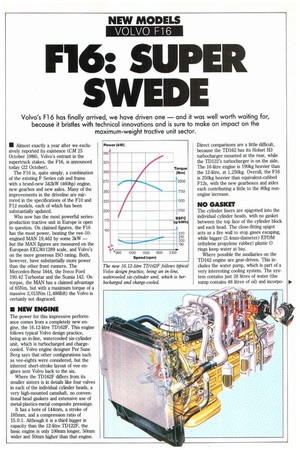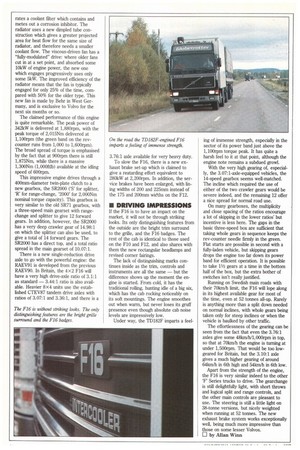F16: SUPER SWED
Page 63

Page 64

If you've noticed an error in this article please click here to report it so we can fix it.
Volvo's Fl 6 has finally arrived, we have driven one — and it was well worth waiting for, because it bristles with technical innovations and is sure to make an impact on the maximum-weight tractive unit sector.
• Almost exactly a year after we exclusively reported its existence (CM 25 October 1986), Volvo's entrant in the supertruck stakes, the F16, is announced today (22 October).
The F16 is, quite simply, a combination of the existing F Series cab and frame with a brand-new 342kW (460hp) engine, new gearbox and new axles. Many of the improvements in the driveline are mirrored in the specifications of the F10 and F12 models, each of which has been substantially updated.
Who now has the most powerful seriesproduction tractive unit in Europe is open to question. On claimed figures, the F16 has the most power, beating the vee-10engined MAN 19,462 by some 3kW — but the MAN figures are measured on the European EEC80/1289 scale, and Volvo's on the more generous ISO rating. Both, however, have substantially more power than the other front runners. The Mercedes-Benz 1644, the Iveco Ford 190.42 Turbostar and the Scania 142. On torque, the MAN has a claimed advantage of 65Nm, but with a maximum torque of a massive 2,015Nm (1,4861bft) the Volvo is certainly not disgraced.
• NEW ENGINE
The power for this impressive performance comes from a completely new engine, the 16.12-litre TD162F. This engine follows typical Volvo design practice, being an in-line, watercooled six-cylinder unit, which is turbocharged and chargecooled. Volvo engine designer Per Swie Berg says that other configurations such as vee-eights were considered, but the inherent short-stroke layout of vee engines sent Volvo back to the six.
Where the TD162F differs from its smaller sisters is in details like four valves in each of the individual cylinder heads, a very high-mounted camshaft, no conventional head gaskets and extensive use of metal-plastics-metal composite pressings.
It has a bore of 144mm, a stroke of .185mm, and a compression ratio of 15.0:1. Although it is a third bigger in capacity than the 12-litre TD122F, the basic engine is only 100mm longer, 50nun wider and 50nun higher than that engine. The new 16.12-litre TD162F follows typical Volvo design practice, being an in-line, watercooled six-cylinder unit, which is turbocharged and charge-coaled. Direct comparisons are a little difficult, because the TD162 has its Holset H3 turbocharger mounted at the rear, while the TD122's turbocharger is on the side. The 16-litre engine is 190kg heavier than the 12-litre, at 1,250kg. Overall, the F16 is 250kg heavier than equivalent-cabbed F12s, with the new gearboxes and axles each contributing a little to the 80kg nonengine increase.
NO GASKET
The cylinder liners are spigotted into the individual cylinder heads, with no gasket between the top face of the cylinder block and each head. The close-fitting spigot acts as a fire wall to stop gases escaping, while bigger (2.4mm-diameter) EPDM (ethylene propylene rubber) plastic 0 rings keep water at bay.
Where possible the auxiliaries on the TD162 engine are gear-driven. This includes the water pump, which is part of a very interesting cooling system. The system contains just 28 litres of water (the sump contains 48 litres of oil) and incorpo rates a coolant filter which contains and metes out a corrosion inhibitor. The radiator uses a new dimpled tube construction which gives a greater projected area for heat flow for the same size of radiator, and therefore needs a smaller coolant flow. The viscous-driven fan has a "fully-modulated" drive: where older fans cut in at a set point, and absorbed some 10kW of engine power, the new one which engages progressively uses only some 5kW. The improved efficiency of the radiator means that the fan is typically engaged for only 25% of the time, compared with 50% for the older type. This new fan is made by Behr in West Germany, and is exclusive to Volvo for the next six months or so.
The claimed performance of this engine is quite remarkable. The peak power of 342kW is delivered at 1,880rpm, with the peak torque of 2,015Nm delivered at 1,100rpm (the green band on the revcounter runs from 1,000 to 1,600rpm). The broad spread of torque is emphasised by the fact that at 900rpm there is still 1,875Nm, while there is a massive 1,300Nm (1,000ftlb) available at the idling speed of 600rpm.
This impressive engine drives through a 400mrn-diameter twin-plate clutch to a new gearbox, the SR2000 CS' for splitter, 'R' for range-change, '2000' for 2,000Nm nominal torque capacity). This gearbox is very similar to the old SR71 gearbox, with a three-speed main gearset with rangechange and splitter to give 12 forward gears. In addition, however, the SR2000 has a very deep crawler gear of 14.98:1 on which the splitter can also be used, to give a total of 14 forward gears. The SR2000 has a direct top, and a total ratio spread in the main gearset of 10.07:1.
There is a new single-reduction drive axle to go with the powerful engine: the RAE V91 is developed from the previous RAEV90. In Britain, the 4x2 F16 will have a very high drive-axle ratio of 3.1:1 as standard — 3A4:1 ratio is also available. Heavier 8x4 units use the established CTEV87 tandem drive axles with ratios of 3.07:1 and 3.36:1, and there is a 3.76:1 axle available for very heavy duty.
To slow the F16, there is a new exhaust brake set-up which is claimed to give a reatarding effort equivalent to 280kW at 2,200rpm. In addition, the service brakes have been enlarged, with lining widths of 200 and 225mm instead of the 175 and 200mm widths on the F12.
• DRIVING IMPRESSIONS
If the F16 is to have an impact on the market, it will not be through striking looks. Its only distinguishing features from the outside are the bright trim surround to the grille, and the F16 badges. The rest of the cab is identical to those used on the F10 and F12, and also shares with them the new rectangular headlamps and revised corner fairings.
The lack of distinguishing marks continues inside as the trim, controls and instruments are all the same — but the difference shows up the moment the engine is started. From cold, it has the traditional rolling, hunting idle of a big six, which has the cab rocking noticeably on its soft mountings. The engine smoothes out when warm, but never loses its gruff presence even though absolute cab noise levels are impressively low.
Under way, the TD182F imparts a feel ing of immense strength, especially in the sector of its power band just above the 1,100rpm torque peak. It has quite a harsh feel to it at that point, although the engine note remains a subdued growl.
With the very high gearing of, especially, the 3.07:1-axle-equipped vehicles, the 14-speed gearbox seems well-matched. The incline which required the use of either of the two crawler gears would be severe indeed, and the remaining 12 offer a nice spread for normal road use.
On many gearboxes, the multiplicity and close spacing of the ratios encourage a lot of skipping in the lower ratios' but incentive is less here. The gaps in the basic three-speed box are sufficient that taking whole gears in sequence keeps the rev-counter needle firmly in the green. Flat starts are possible in second with a fully-laden vehicle, but skipping gears drops the engine too far down its power band for efficient operation. It is possible to take 11/2 gears at a time in the bottom half of the box, but the extra bother of switches isn't really justified.
Running on Swedish main roads with their 701cm/h limit, the F16 will lope along in its highest available gear for most of the time, even at 52 tonnes all-up. Rarely is anything more than a split down needed on normal inclines, with whole gears being taken only for steep inclines or when the vehicle is baulked by other traffic.
The effortlessness of the gearing can be seen from the fact that even the 3.76:1 axles give some 481crn/h/1,000rpm in top, so that at 701cm/h the engine is turning at under 1,500rpm. That would be too lowgeared for Britain, but the 3.10:1 axle gives a much higher gearing of around 641cm/h in 6th high and 54km/h in 6th low.
Apart from the strength of the engine, the F16 is very similar indeed to the other 'F' Series trucks to drive. The gearchange is still delightfully light, with short throws and logical split and range controls, and the other main controls are pleasant to use. The steering is still a little light on 38-tonne versions, but nicely weighted when running at 52 tonnes. The new exhaust brake system works exceptionally well, being much more impressive than those on some lesser Volvos.












































































































































































